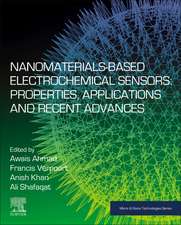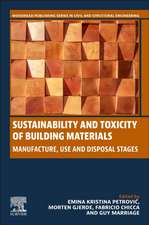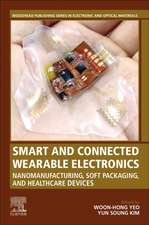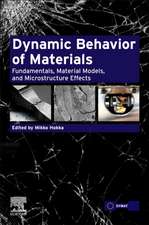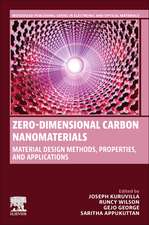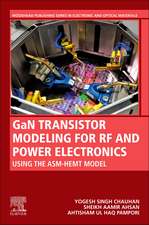Design and Manufacture of Structural Composites: Woodhead Publishing Series in Composites Science and Engineering
Editat de Lee Harper, Mike Clifforden Limba Engleză Paperback – 2 dec 2022
Design and Manufacture of Structural Composites provides an overview of the most common manufacturing routes for fiber reinforced composites, including the influence of the manufacturing route on mechanical properties. It discusses the intermediate steps to convert common fiber/matrix combinations into finished products and provides an insight into some of the most common research challenges for each of the chosen manufacturing processes, covering experimental, analytical and numerical analysis. Particular emphasis is placed on the various types of manufacturing routes for fiber reinforced composites, including the influence of the manufacturing route on mechanical properties, automation, additive manufacturing and recyclability, and material properties and design principles.
Chapters cover introduction to composite materials, material preforming and conversion, moulding, enabling technologies, computer aided engineering, reduce, reuse and recycling, and much more.
Din seria Woodhead Publishing Series in Composites Science and Engineering
- 29%
 Preț: 1153.66 lei
Preț: 1153.66 lei - 29%
 Preț: 1477.86 lei
Preț: 1477.86 lei - 24%
 Preț: 1160.48 lei
Preț: 1160.48 lei - 39%
 Preț: 1153.30 lei
Preț: 1153.30 lei - 24%
 Preț: 1451.12 lei
Preț: 1451.12 lei - 9%
 Preț: 1019.80 lei
Preț: 1019.80 lei - 29%
 Preț: 1129.94 lei
Preț: 1129.94 lei - 9%
 Preț: 1049.32 lei
Preț: 1049.32 lei - 29%
 Preț: 1067.77 lei
Preț: 1067.77 lei - 9%
 Preț: 1069.37 lei
Preț: 1069.37 lei - 29%
 Preț: 1326.23 lei
Preț: 1326.23 lei - 29%
 Preț: 1243.53 lei
Preț: 1243.53 lei - 29%
 Preț: 1213.41 lei
Preț: 1213.41 lei - 39%
 Preț: 1155.04 lei
Preț: 1155.04 lei - 9%
 Preț: 1006.50 lei
Preț: 1006.50 lei - 29%
 Preț: 1067.31 lei
Preț: 1067.31 lei - 9%
 Preț: 1140.31 lei
Preț: 1140.31 lei - 24%
 Preț: 1130.30 lei
Preț: 1130.30 lei - 9%
 Preț: 1069.99 lei
Preț: 1069.99 lei - 24%
 Preț: 1130.20 lei
Preț: 1130.20 lei - 9%
 Preț: 904.59 lei
Preț: 904.59 lei - 23%
 Preț: 999.51 lei
Preț: 999.51 lei - 9%
 Preț: 1542.98 lei
Preț: 1542.98 lei - 23%
 Preț: 992.64 lei
Preț: 992.64 lei - 9%
 Preț: 1210.03 lei
Preț: 1210.03 lei - 9%
 Preț: 1328.05 lei
Preț: 1328.05 lei - 24%
 Preț: 1563.73 lei
Preț: 1563.73 lei - 24%
 Preț: 1159.26 lei
Preț: 1159.26 lei - 24%
 Preț: 1559.63 lei
Preț: 1559.63 lei - 9%
 Preț: 1212.62 lei
Preț: 1212.62 lei - 29%
 Preț: 1158.40 lei
Preț: 1158.40 lei - 28%
 Preț: 1075.60 lei
Preț: 1075.60 lei - 29%
 Preț: 1158.75 lei
Preț: 1158.75 lei - 29%
 Preț: 925.09 lei
Preț: 925.09 lei - 29%
 Preț: 1417.65 lei
Preț: 1417.65 lei - 9%
 Preț: 989.97 lei
Preț: 989.97 lei - 29%
 Preț: 1479.85 lei
Preț: 1479.85 lei - 9%
 Preț: 1335.20 lei
Preț: 1335.20 lei - 29%
 Preț: 1189.81 lei
Preț: 1189.81 lei - 9%
 Preț: 1069.82 lei
Preț: 1069.82 lei - 33%
 Preț: 946.33 lei
Preț: 946.33 lei - 24%
 Preț: 955.72 lei
Preț: 955.72 lei - 29%
 Preț: 1186.95 lei
Preț: 1186.95 lei - 29%
 Preț: 1393.64 lei
Preț: 1393.64 lei - 9%
 Preț: 1011.50 lei
Preț: 1011.50 lei - 9%
 Preț: 1071.27 lei
Preț: 1071.27 lei - 24%
 Preț: 1234.77 lei
Preț: 1234.77 lei - 9%
 Preț: 1208.48 lei
Preț: 1208.48 lei - 9%
 Preț: 1308.84 lei
Preț: 1308.84 lei - 29%
 Preț: 1311.49 lei
Preț: 1311.49 lei
Preț: 1218.43 lei
Preț vechi: 1991.42 lei
-39% Nou
233.14€ • 244.08$ • 192.91£
Carte tipărită la comandă
Livrare economică 29 martie-12 aprilie
Specificații
ISBN-10: 0128191600
Pagini: 584
Ilustrații: 210 illustrations (30 in full color)
Dimensiuni: 152 x 229 mm
Greutate: 0.77 kg
Editura: ELSEVIER SCIENCE
Seria Woodhead Publishing Series in Composites Science and Engineering
Public țintă
Materials scientist, Materials engineer, Metallurgist, Ceramics engineer, Mechanical engineer, Aerospace engineer Materials Science and Engineering, Ceramics Engineering, Mechanical Engineering, and Aerospace Engineering at universities, government labs, research institutes; Graduate students and undergraduate students at universities worldwide with departments and/or degree programs in Materials Science and Engineering, Ceramics Engineering, Mechanical Engineering, and Aerospace EngineeringCuprins
Part I. Introduction to composite materials 1. Fibres 2. Resins 3. Intermediates (weaving, NCF, prepreg, compounds) 4. Applications 5. Composites Roadmap – Where is the industry heading?
Part II. Material Preforming and Conversion 6. 2D to 3D dry fibre preforming (press forming, diaphragm forming) 7. Automated Fibre Placement (AFP / ATL) 8. Braiding 9. Filament winding 10. 3D weaving
Part III. Moulding 11. Autoclaving Prepreg 12. Injection Moulding & Over-moulding 13. Compression Moulding 14. Thermoplastic Stamping 15. Liquid Resin Infusion (incl. in-situ polymerization)
Part IV. Enabling Technologies 16. Tooling Design 17. Automation (pick and place etc) 18. Quality Assurance (inc NDT / Inspection) 19. Microwave Processing 20. Additive Manufacturing
Part V. Computer Aided Engineering 21. Process Simulation 22. Factory Simulation 23. Industry 4.0 /Virtual Machine Design 24. Design for Manufacture 25. Cost, rate and robustness
Part VI. Reduce, Reuse, Recycle 26. Waste Reduction 27. Disassembly 28. Fibre Recovery 29. Recyclate Conversion 30. Life Cycle Analysis
Descriere
Design and Manufacture of Structural Composites provides an overview of the most common manufacturing routes for fiber reinforced composites, including the influence of the manufacturing route on mechanical properties. It discusses the intermediate steps to convert common fiber/matrix combinations into finished products and provides an insight into some of the most common research challenges for each of the chosen manufacturing processes, covering experimental, analytical and numerical analysis. Particular emphasis is placed on the various types of manufacturing routes for fiber reinforced composites, including the influence of the manufacturing route on mechanical properties, automation, additive manufacturing and recyclability, and material properties and design principles.
Chapters cover introduction to composite materials, material preforming and conversion, moulding, enabling technologies, computer aided engineering, reduce, reuse and recycling, and much more.
- Discusses recent advances in composite manufacturing, automation, additive manufacturing and recyclability
- Presents various types of manufacturing routes for fiber reinforced composites, including the influence of the manufacturing route on mechanical properties
- Emphasizes recycling, design simulations and additive manufacturing


